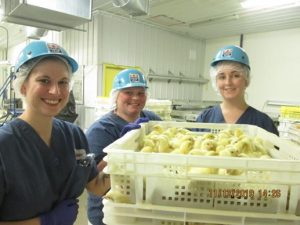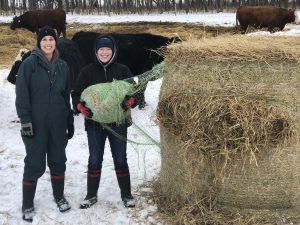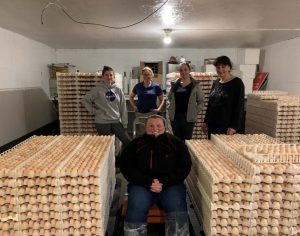 John Basarab chatted with Gentec about his new position as Head of Beef Operations. The highlights of that conversation are below.
John Basarab chatted with Gentec about his new position as Head of Beef Operations. The highlights of that conversation are below.
Gentec: What’s the background to your move to Gentec/UAlberta after 30+ years with the Alberta government?
Basarab: Well, the story goes back several years. With Alberta Agriculture and Forestry, I built a successful research program in beef production, management, genetics and genomics. During a lot of that time, I was an adjunct professor at UAlberta as well, and involved in the Alberta Bovine Genome Program, led by Steve Moore. When feed efficiency became a big thing in Alberta and Australia in the early 2000s, my program became the phenotyping arm for feed efficiency, growth and carcass traits for the Program, which morphed into Gentec. (More recently, female fertility and longevity, and impacts on methane emissions have been added to the phenotypes for genetic/genomic analyses.)
Then, last year, Alberta Agriculture and Forestry changed its focus away from performing research towards funding research. Some programs, like mine, were transferred to UAlberta where I was appointed to a senior role to help strengthen research and discovery at the Faculty to help deliver tangible benefits for farmers. That’s how I—and some resources and phenotyping tech support—ended up at the University. It’s a good marriage.
Gentec: So, do you work for UAlberta or Gentec?
Basarab: Like the other lead Gentec scientists, I’m hired by the University. Others are hired by Agriculture and Agri-Food Canada or other academic institutions. Gentec is a group of like-minded people collaborating on projects in animal genomics, phenomics and business. It relies on that likemindedness to advance its strategic plan, which is highly related to the beef industry’s strategic plan. That’s how we were able to put together a large tech transfer project for the beef industry (see EnVigour HX ™) and get it funded. In any year, Gentec carries projects worth over $25 million.
Gentec: So, you could have gone anywhere. Why Gentec?
Basarab. Gentec is a mechanism like few others for coordinating research and technology transfer activities. It’s almost like picking an all-star team. Gentec’s model is to say: we need good beef genomics and knowledge translation people. Where can we find them, and how do we get them to collaborate? The answer is: get them to buy into group values and objectives, and engage them on a project to fulfil industry needs.
Gentec: Did the funding from Alberta Innovates and Results-Driven Agriculture Research (RDAR) come with your move or was it coincidental?
Basarab: The project model is a good one but hard to sustain because we have to chase funds to retain basic staff, and generate some revenue. We’re good at generating ideas and winning grants. Then the IP gets developed and licensed out. Then we’re back to square one. Gentec’s new strategic plan reflects a change in direction, encouraging us to generate enough revenue to move forward, to deliver tools to producers that improve their bottom line and that are easier to use. So, these two tranches of funding coincided with my arrival—but I do bring the industry focus they’re looking for. RDAR, especially, is looking for solutions to industry challenges.
Gentec: Your title is Head of Beef Operations. What does that mean? What is your role?
Basarab: Well, the main thing is to implement the strategic plan, especially as it relates to the beef industry. So that means identify research, communication and extension activities that focus on industry challenges. Then go after funding. We’re doing a lot of that already. Several projects have been approved or are in the final round of competition.
We’ll capitalize on our deep relationships with the beef industry to solve industry challenges, and not just through genomics. We’ll look at emerging, data-driven technologies, like the smart farm, and develop software and analytics so that real-time data collection informs real-time decisions to benefit producers.
We’ll deepen our relationships with organizations like the Canadian Cattlemen’s Association, Beef Cattle Research Council (BCRC), Canadian Beef Breeds Council, and the Canadian Beef Improvement Network to keep the research moving forward along industry lines. A key guidance document is the BCRC 2018-2023 Strategic Plan, which focuses on enhanced feed and forage production, improving feed efficiency, decreasing impacts on animal health, improving consumer confidence in beef and environmental sustainability. Several of these areas, like improving feed and production efficiency, optimizing carcass cut-out value and reducing the carbon footprint of beef production lend themselves well to genetic and genomic selection.
And, of course, we can never stop thinking about the research. All the above will come together to provide a rich learning environment and 360-degree industry awareness that attracts grad students who have a strong interest in agriculture and want to stay in Alberta and Canada. And I’m sure that the new research chair (Dr. Gleise da Silva) will collaborate with Gentec, UAlberta and AAFC researchers, tech transfer staff and industry.
Gentec: What excites you about the next steps for Gentec?
Basarab: We have this great genomic-phenomic dataset—unique to Canada in beef cattle—that now allows us to generate all sorts of genomics tools for the beef industry. Those tools will work because the database has been created from cattle in Western Canada. These are homegrown genotypes and phenotypes from our own backyard. I’m so excited about bring these solutions to our beef industry.



 John Basarab chatted with Gentec about his new position as Head of Beef Operations. The highlights of that conversation are below.
John Basarab chatted with Gentec about his new position as Head of Beef Operations. The highlights of that conversation are below.

